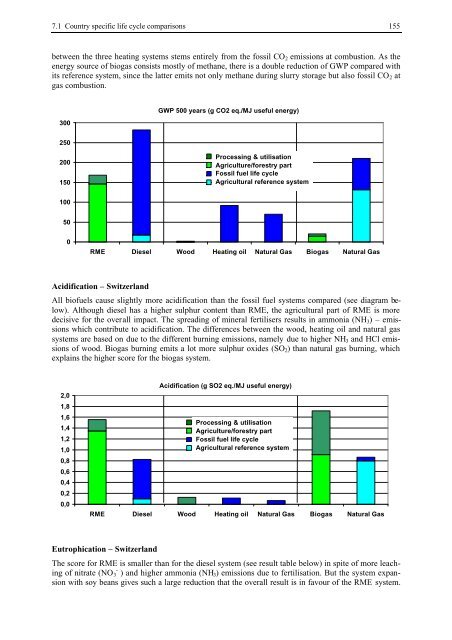BIOENERGY FOR EUROPE: WHICH ONES FIT BEST?
BIOENERGY FOR EUROPE: WHICH ONES FIT BEST?
BIOENERGY FOR EUROPE: WHICH ONES FIT BEST?
Create successful ePaper yourself
Turn your PDF publications into a flip-book with our unique Google optimized e-Paper software.
7.1 Country specific life cycle comparisons 155<br />
between the three heating systems stems entirely from the fossil CO2 emissions at combustion. As the<br />
energy source of biogas consists mostly of methane, there is a double reduction of GWP compared with<br />
its reference system, since the latter emits not only methane during slurry storage but also fossil CO2 at<br />
gas combustion.<br />
300<br />
250<br />
200<br />
150<br />
100<br />
50<br />
0<br />
GWP 500 years (g CO2 eq./MJ useful energy)<br />
Processing & utilisation<br />
Agriculture/forestry part<br />
Fossil fuel life cycle<br />
Agricultural reference system<br />
RME Diesel Wood Heating oil Natural Gas Biogas Natural Gas<br />
Acidification – Switzerland<br />
All biofuels cause slightly more acidification than the fossil fuel systems compared (see diagram below).<br />
Although diesel has a higher sulphur content than RME, the agricultural part of RME is more<br />
decisive for the overall impact. The spreading of mineral fertilisers results in ammonia (NH3) – emissions<br />
which contribute to acidification. The differences between the wood, heating oil and natural gas<br />
systems are based on due to the different burning emissions, namely due to higher NH3 and HCl emissions<br />
of wood. Biogas burning emits a lot more sulphur oxides (SO2) than natural gas burning, which<br />
explains the higher score for the biogas system.<br />
2,0<br />
1,8<br />
1,6<br />
1,4<br />
1,2<br />
1,0<br />
0,8<br />
0,6<br />
0,4<br />
0,2<br />
0,0<br />
Acidification (g SO2 eq./MJ useful energy)<br />
Processing & utilisation<br />
Agriculture/forestry part<br />
Fossil fuel life cycle<br />
Agricultural reference system<br />
RME Diesel Wood Heating oil Natural Gas Biogas Natural Gas<br />
Eutrophication – Switzerland<br />
The score for RME is smaller than for the diesel system (see result table below) in spite of more leaching<br />
of nitrate (NO3 - ) and higher ammonia (NH3) emissions due to fertilisation. But the system expansion<br />
with soy beans gives such a large reduction that the overall result is in favour of the RME system.

















